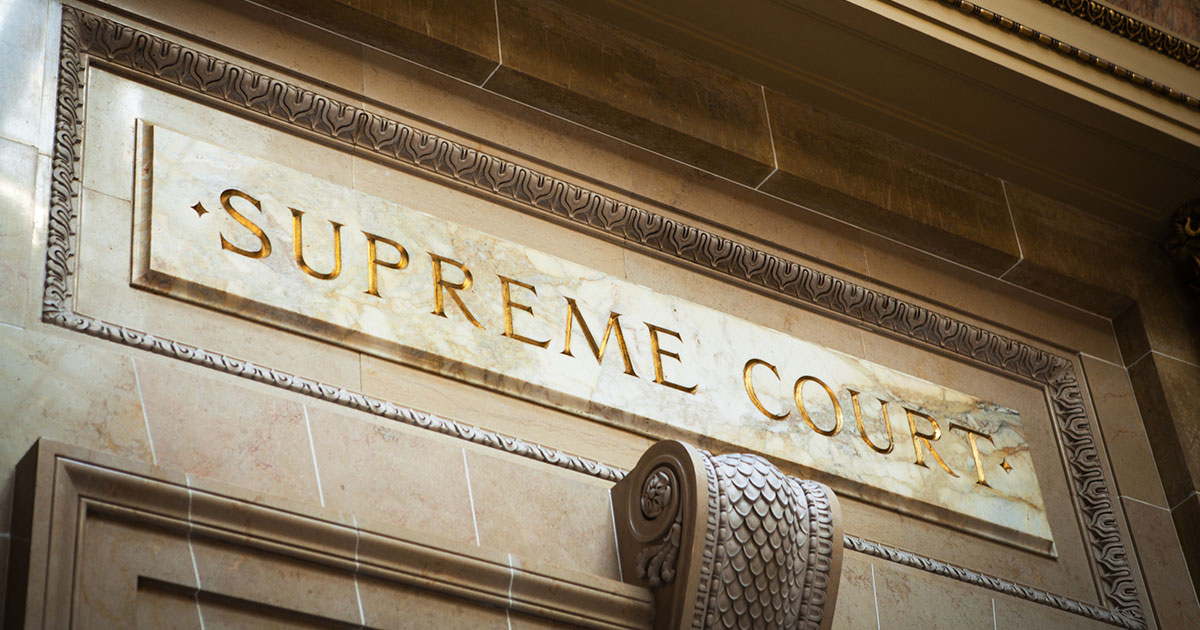
July 25, 2025 – In the past 50 years, the Wisconsin Legislature effectively wrote out of existence an 1849 abortion law, a 4-3 majority of the Wisconsin Supreme Court concluded this month in holding the original law impliedly repealed in Kaul v. Urmanski, 2025 WI 32.
“We conclude that comprehensive legislation enacted over the last 50 years regulating in detail the ‘who, what, where, when, and how’ of abortion so thoroughly covers the entire subject of abortion that it was meant as a substitute for the 19th century near-total ban on abortion,” wrote Justice Rebecca Frank Dallet for the majority.
The majority held that the Legislature had impliedly repealed Wis. Stat. section 940.04(1), making abortion legal in Wisconsin.
 Jay D. Jerde, Mitchell Hamline 2006, is a legal writer for the State Bar of Wisconsin, Madison. He can be reached by email or by phone at (608) 250-6126.
Jay D. Jerde, Mitchell Hamline 2006, is a legal writer for the State Bar of Wisconsin, Madison. He can be reached by email or by phone at (608) 250-6126.
Chief Justice Jill J. Karofsky and Justices Ann Walsh Bradley and Janet C. Protasiewicz joined the majority opinion.
Chief Justice Karofsky wrote a concurring opinion offering a history of abortion in the U.S., and “conclude[d] by elevating the accounts of four women to illustrate the real-world consequences of severe abortion restrictions.”
The Supreme Court also dismissed Planned Parenthood of Wisconsin v. Urmanski, 2025 WI 33, which raised claims under the Wisconsin Constitution against the abortion statute.
Three Dissents
All three dissents faulted the majority for a policy-based decision that the constitution leaves to the Legislature to decide.
Justice Brian K. Hagedorn, joined by Justice Rebecca Grassl Bradley, concluded that, “[a]t every point, the majority falls on its face. There is no singular act, the scattered provisions do not cover the entire field of abortion policy, and later statutory enactments prove without question that the [L]egislature did not intend to repeal the law.”
“[O]ne should pause and ask what price has been paid for today’s decision,” Justice Annette Kingsland Zieger summarized, “the people of Wisconsin’s ability to democratically decide for themselves what the laws of the state shall be, the separation of powers between the branches of our state government, and this court’s credibility as a neutral judicial body – to name but a few of the costs.”
“Those who ‘win’ today may like the result, but an activist court – whether liberal or conservative – endangers the rule of law and offends the constitution,” Justice Ziegler emphasized.
In addition to these constitutional concerns, Justice R.G. Bradley’s dissent disputed the history recited in Chief Justice Karofsky’s concurrence.
“Laden with emotion, steeped in myth, and light on the law, the concurrence reads as a parody of progressive politics rather than the opinion of a jurist,” Justice R.G. Bradley wrote.
Declaratory Judgment
The U.S. Supreme Court decision Roe v. Wade, 410 U.S. 113 (1973), prohibited criminalizing abortion, but Dobbs v. Jackson Women’s Health Organization, 597 U.S. 215 (2022) held that the U.S. Constitution “does not protect the right to abortion.”
Attorney General Josh Kaul, the Department of Safety and Professional Services (DSPS), the Medical Examining Board, that Board’s chairman, and three intervening physicians, sought a declaratory judgment that the Wisconsin statute doesn’t ban abortions.
They named as defendants the district attorneys of Sheboygan County, Joel Urmanski, Milwaukee County, John Chisholm, and Dane County, Ismael Ozanne.
Dane County Circuit Court issued a declaratory judgment that the statute “does not prohibit abortions.” The Supreme Court accepted the case on bypass.
‘Giving Effect’ to Laws
Of the “two narrow circumstances” of implied repeal, the majority applied the one “when the [L]egislature adopts comprehensive legislation through one or more acts that so thoroughly covers the entire subject of the earlier statute that it was clearly meant as a substitute for that earlier law.”
Although cases may describe a single legislative enactment, implied repeal can involve multiple enactments, the majority noted.
Since 1985, ten Wisconsin statutes have limited abortions, the majority explained, such as criminalizing abortions after viability, limiting “partial-birth abortions,” and specifying notification requirements.
Eight additional statutes govern when government funds may be used to pay for abortions, the majority said.
“Collectively, these statutes constitute ‘comprehensive legislation’ encompassing the ‘entire subject’ of abortion and establishing ‘elaborate inclusions and exclusions of the persons, things, and relationships ordinarily associated with the subject” – the majority summarized – “often in extraordinary detail.”
“[I]f abortion is illegal at all times,” such laws would be unnecessary, nor would “statutes specifically authorize the state, counties, or municipalities to subsidize a crime,” the majority said.
“This conclusion is consistent with decisions by several other courts holding that comprehensive legislation governing abortion impliedly repealed earlier abortion bans,” the majority said in noting cases in Texas, Arkansas, Louisiana, and West Virginia.
Although Urmanski argued that statutory changes demonstrated the Legislature’s awareness of section 940.04(1)’s validity, the majority found “far more compelling explanations for these changes.”
“In conclusion, this case is about giving effect to 50 years’ worth of laws passed by the [L]egislature …. The [L]egislature, as the peoples’ representatives, remains free to change the laws with respect to abortion in the future.”
‘Opposite of How This Works’
Justice Hagedorn’s dissent addressed head-on the majority’s analysis and found it erroneous.
The elements for implied repeal by substitution, Justice Hagedorn said, requires: “1) a singular act; 2) covering the whole field; 3) that was clearly intended to be the sole governing law on the topic.”
Absent a singular act that covers the field, “the majority reasons that a host of narrower statutes applying to some abortions impliedly repealed a broader statute applying to all abortions. That is exactly the opposite of how this works,” Hagedorn explained.
“A smattering of specific and narrow acts over time could not impliedly repeal a far more comprehensive law. They may “answer lots of questions, but that doesn’t mean they repeal any older law on the same topic.”
The several statutes Hagedorn likened to “overlapping criminal prohibitions” that can exist together in the statutes, chosen by prosecutorial discretion in enforcement.
Legislative intent fails to justify implied repeal, Justice Hagedorn emphasized. It says the opposite.
“Of particular import here, we have said that when the [L]egislature amends a statute and does not explicitly repeal it, a ‘finding of a repeal by implication [is] simply impossible,’” Hagedorn said in quoting Wisconsin precedent.
“Instead, the abortion statutes in Wisconsin developed against the backdrop and in response to Roe v. Wade,” Hagedorn explained. The newer statutes followed the contours allowed for abortions based on U.S. Supreme Court holdings, while legislative history showed the intent to retain the existing criminal statute.
The Legislature’s 2001 amendment of section 940.04(1) to change the penalty is “a dispositive indication that the [L]egislature did not repeal it.” Amendments to the statute in 2011 and 2015 reinforce the statute’s viability, Hagedorn reinforced.
‘Death Warrants’
“In deciding that the [L]egislature impliedly repealed” section 940.04(1), Chief Justice Karofsky wrote in her concurrence, “the women and children of our state are shielded from the brutal consequences the statute wrought.”
From her historical sources, since Colonial times “abortions were widely available” but were gradually prohibited by the 1850s, primarily for moral, not “women’s health,” reasons.
The shadow of Dobbs created uncertainty about the Wisconsin statute that “left victims of sexual assault and others seeking reproductive healthcare in limbo,” Chief Justice Karofsky wrote. In other states, three women have died unnecessarily because of such uncertainty.
And in 1929, Chief Justice Karofsky’s great-grandmother, lacking access “to medical care necessary for an abortion,” died.
These stories “remind us that severe abortion restrictions operate like death warrants,” Chief Justice Karofsky concluded.
‘Legislature Should Clarify’
“It is the court’s duty to adhere to the law whether we ‘like’ the answer or not,” Justice Ziegler wrote in her dissent. “A judge’s personal preferences are not legal analysis and should not supplant it.”
“The Wisconsin Legislature should clarify the statutes in light of Dobbs and have the debate, testimony, and dialogue that accompanies legislative action. Such legislative action, even if vetoed by the Governor, serves the public, shaping public opinion and moving the issue to the fore.”
But she clarified, “Current legislative inaction, however, is no excuse for judicial activism.”
‘Four Lawyers’
Noting that members in the majority ran for election or supported others for their positions on abortion, Justice R.G. Bradley’s dissent pointed out that the majority’s methodology is bad, whether used by liberals or conservatives.
“The People of Wisconsin have surrendered self-governance to four liberal lawyers. No one, regardless of political leanings, should want any four lawyers to make all of the important decisions for we the People,” Justice R.G. Bradley emphasized.
While disputing the history in Chief Justice Karofsky’s concurrence, noting that abortion was a crime from before the days of Blackstone, and providing more information on the causes of death of three recent women, Justice R.G. Bradley recognized the loss.
“She understandably mourns these women,” Justice R.G. Bradley wrote of Chief Justice Karofsky. “America mourns with her. Legal judgments, however, must be grounded in law, not grief.”
This article was originally published on the State Bar of Wisconsin’s Wisbar Court Review blog, which covers case decisions and other developments in the Wisconsin Supreme Court, the Wisconsin Court of Appeals, and the U.S. Court of Appeals for the Seventh Circuit. To contribute to this blog, contact Joe Forward.
